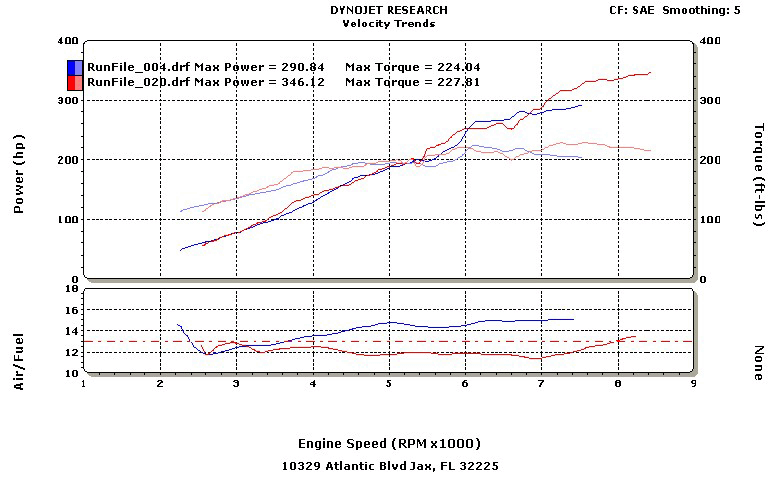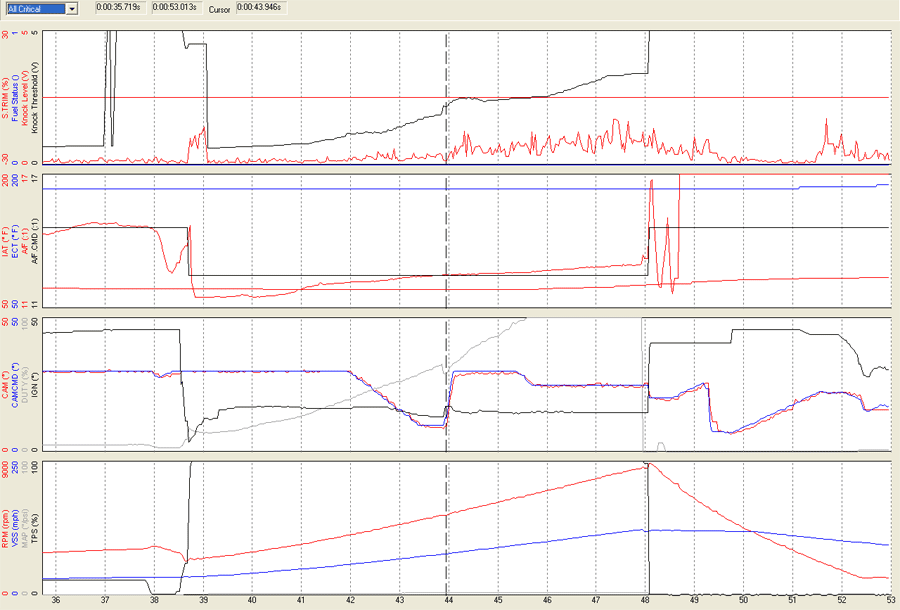Over the past several months there has been a lot of speculation
of what
the Guardian is and how it works. During the last week, I have done
considerable testing using a Cybernation Stage 1 turboed RSX-S. Below is a
summary of my findings.
Test Car: 2004 Acura RSX-S
- Cybernation Stage I turbo kit (T3/T4 turbo)
- Cybernation's 3.5ohm 550cc injectors
- Cybernation's Guardian E.I. Engine Management
- 3in Downpipe
- 3in Exhaust 10psi of boost
The test car was verified to be working correctly by Cybernation in December 2004.
Testing tools
- Honda scan tool
- standalone PLX
wideband oxygen sensor(02S)
- Dynojet from Velocity Trends, Jax Fl.
904.997.9903 (Contact Steve)
Testing procedures
The Honda scan tool is used to read the stock ECU's sensors
via the OBDII
port. In this case, it was used to visually see what control the Guardian
piggyback has on the ECU. The scan tool reads all major sensors and ECU
activities including, but not limited to, ignition advance, knock
retard, injector pulse width, both stock O2S,
closed/open loop operation, cam angle, short term fuel trim (s.trim), long
term fuel trim (l.trim), air/fuel command (AFCMD), vehicle speed (VSS),
calculated load value (CLV), intake air temp (IAT), engine coolant temp
(ECT). From the ECU's sensor readings one can figure out what control the
piggyback has on the stock ECU. The scan tool also has datalogging features
which allow the tester to datalog up to 12 seconds at a time.
The PLX wide-band O2S is used to measure air/fuel ratios
(AFRs) from the
exhaust; and is a standalone unit. This means it is completely separate from
the
front and rear O2 sensors and does not effect the Guardian's operation. The
PLX wide-band can read from 10.0:1(rich) and 18.0:1(lean). A third O2 bung
was installed in the exhaust of the test car just behind the secondary O2S.
The PLX was installed into this O2 bung for testing. (NOTE: This is not a
sniffer O2S. It is installed directly into the exhaust system and is
extremely accurate.) The voltage from the PLX is sent to the control unit
which reads the voltage and converts it to a lambda reading (AFR) which is
displayed on the control unit's digital display.
The RSX was driven by Steve from Velocity Trends
Initial testing results
Street pulls in 3rd gear were used starting at 2000 rpm and
taken to around
8000rpm(Guardian retains the stock rev-limiter of 8100). Here are the
results from the first phase of testing. Run number 1 was aborted due to
intercooler coupling coming off of the throttlebody.
Run 2*:
RPM |
IGNITION |
AFR |
2285 |
24 |
10.0 |
2613 |
19 |
11.61 |
2962 |
20.5 |
13.09 |
3795 |
15 |
13.68 |
4737 |
10.5 |
13.44 |
5712 |
18.5 |
13.87 |
*Leanset AFR for Run
# 2: 14.26 at 5200rpm
Run #2 aborted early due to very lean AFR's.
Run 3*:
RPM |
IGNITION |
AFR |
2725 |
17.5 |
12.72 |
3598 |
15.5 |
13.34 |
4542 |
13 |
13.84 |
5530 |
10 |
14.23 |
6625 |
16.5 |
13.44 |
7614 |
12.5 |
12.90 |
*Leanest AFR for Run # 3: 14.31 at 5200rpm
Run 4*:
RPM |
IGNITION |
AFR |
2033 |
16 |
12.13 |
2544 |
16.5 |
11.49 |
3325 |
19 |
13.36 |
4263 |
14.5 |
12.83 |
5281 |
9.5 |
13.79 |
6286 |
17.5 |
13.26 |
7281 |
13 |
12.67 |
*Leanest AFR for Run # 4: 13.85 at 5300rpm
Click here for video of street run # 3
Idle
At idle, the S.trim is pegged at
-27.3% which is the most fuel the stock ECU
can pull out. At a high idle of 2000rpm, the AFRs are in the 10 - 11s and
s.trim is again pegged at -27.3%.
In closed loop the stock
ECU self tunes for the target AFR of 14.7:1. The
area of closed loop operation consists of idle and light throttle loads. This
is
where an AFR of 14.7:1 is best for economy and emissions. The ECU tunes on
the fly for this target AFR via it's readings from the primary and secondary
O2S. If the ECU's readings of it's sensors tell it it's running too rich,
the ECU will pull out fuel via the short term fuel trim (s.trim). The long
term fuel trim (l.trim) is the ECU's overall average of the s.trim. The ECU
also uses the Air Fuel Ratio Command (AFCMD) to manage the ECU's closed loop
self tuning. The ECU will switch to open loop once several conditions have
been met. One condition is that the throttle position sensor (TPS) has to
be more than
25%. Another condition is that there is sometimes a 2-3 second delay after
gearshift
during which the ECU stays in closed loop. At this point, the ECU stops its
self tuning and follows the tables in the ECU's memory. The Guardian, like
the AFC, intercepts and manipulates MAP signals to the ECU to alter the
fueling and ignition.
Conclusion
As you can see, the AFRs
are very inconsistent and very lean for a turbo
charged engine. The results shown above are most likely the result from the
Guardian's use of the secondary O2S, which is a narrowband O2S and is not
very accurate, especially as the sensor is heated by the turbo's exhaust
gas.
Ignition timing is too advanced
for boost and is somewhat inconsistent. The
Guardian, like the AFC alters fueling by manipulating the MAP sensor
voltage to the stock ECU. It needs to do this to run with larger injectors,
otherwise the car would run far too rich. This causes the ECU to lookup data
from parts of the maps where ignition is more advanced. Overadvanced
ignition puts extra stress on rods and pistons. Compare ignition timing
recorded above with the Guardian to the K-Pro tuning below.
Important Notes
Guardian wiring
Inputs (these wires are tapped):
- B8 ECT
- B17 IAT
- E26 NEP (RPM signal)
- E2 SHO2 (secondary heated O2 sensor)
Outputs and inputs. (these wires
are cut):
- A19 Map sensor
- E7 Main relay
- TPS
Power
- E4 SG3 (signal ground )
- E9 IG1 (Ignition power)
- E5 Vcc 3 (+ 5V)
After you turn the key on, the Guardian resets all DTC's (Diagnostic Trouble
Codes) and resets the ECU. This also resets all the OBDII readiness codes
and resets the long term fuel trim to zero. You will not be able to pass a
smog test running the Guardian due to this.
Phase Two
The test car was put
on a dynojet chassis dyno and a baseline pull running the
Guardian was made (Blue). After the baseline run with Guardian, the wiring
was returned to stock and a K-Pro ECU was installed in the car (Red). With
no hardware modifications done to the car whatsoever, I began testing and
tuning. The results below show the Guardian's AFRs between 14 and 15:1 as
measured by the dyno's wideband O2S. The PLX wideband showed the similar
AFR's.

The Guardian run was
aborted early due to the AFRs in the
15's. ( Note that the RSX was verified as working correctly by Cybernation
December 2004) Notice the much lower AFRs and ignition timing using the K-Pro
that not only helped spool the turbo faster, but made more power. 56 WHP
was gained with tuning. VTEC was lowered to 5300 rpm resulting in an extra
20WHP from 5300 rpm to 6000 rpm.
More upper mid-range
power can and will be obtained with more tuning. Only
an hour was spent on the dyno. Using the K-Pro, the 550cc injectors maxed
out (hit 100% duty cycle) at 6800rpms.
Click on the above screenshot to view actual datalog (Hondata K-Manager needed)
We will swap to the RC 650cc 12ohm
injectors, install a fuel pressure gauge and
probably a pump as we suspect the stock fuel pump is reaching its limits.
Results will be posted in a few weeks.
Facts:
- The K-Pro tune made more power
than the Guardian
- Ignition timing was lower and more consistent with the K-Pro
- Fuelling was richer and more consistent with the K-Pro
- When tuned for 12:1 AFR the 550cc injectors maxed out at 6800rpm
It is my opinion, considering
the ignition values and AF ratios, that K-Pro
and K-100 tuned RSX is safer than a Guardian
-TeamXRSX (Cary Jordan)
